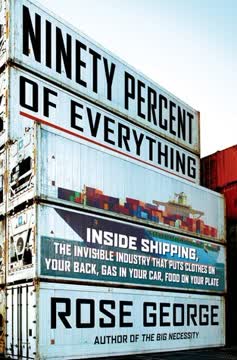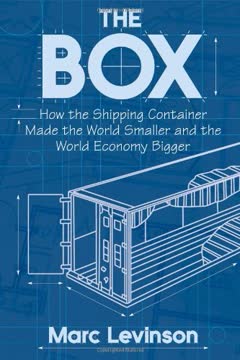Key Takeaways
1. Global Shipping is Invisible Yet Fundamental to Modern Life
"How ironic that the more ships have grown in size and consequence, the less space they take up in our imagination."
Global Trade's Silent Infrastructure. Shipping is the invisible backbone of global commerce, transporting nearly everything humans consume across vast distances. Most people are completely unaware of how dependent they are on maritime transportation for their daily goods, from clothing to electronics to food.
Shipping's Massive Scale. The shipping industry moves an astounding volume of goods worldwide, with container ships capable of carrying tens of thousands of containers across oceans. A single large ship can transport:
- Enough bananas to give one to every European
- Thousands of electronic devices
- Massive quantities of industrial and consumer goods
Economic Significance. Shipping represents a critical yet underappreciated economic sector, enabling global trade and interconnectedness. Despite handling trillions of dollars in goods annually, the industry remains largely unknown to the general public, operating in a complex, global network of ports, routes, and international regulations.
2. Container Ships Are Revolutionary Economic Machines
"Shipping is so cheap that it makes more financial sense for Scottish cod to be sent ten thousand miles to China to be filleted, then sent back to Scottish shops and restaurants, than to pay Scottish filleters."
Technological Game-Changers. Containerization revolutionized global trade by standardizing cargo transportation, dramatically reducing shipping costs and increasing efficiency. The introduction of standardized shipping containers transformed how goods are moved internationally.
Economic Implications:
- Reduced transportation costs
- Increased global trade volumes
- Enabled complex international supply chains
- Made global manufacturing more economically viable
Unprecedented Scale. Modern container ships are engineering marvels, capable of carrying massive quantities of goods across oceans with remarkable efficiency. Some ships can transport:
- 15,000 containers simultaneously
- Equivalent to 746 million bananas
- Cargo worth millions of dollars
3. Seafarers Face Extreme Isolation and Challenging Working Conditions
"Ships are bigger now and need deeper harbors, so they call at Newark or Tilbury or Felixstowe, not Liverpool or South Street."
Psychological and Social Challenges. Seafaring is an incredibly isolating profession, with crew members spending months away from family, in confined spaces, with limited communication and recreational opportunities. Typical challenges include:
- Extended periods away from home
- Minimal internet and communication access
- Small, confined living spaces
- Multinational crews with language barriers
Mental Health Risks. The maritime environment presents significant psychological pressures, including:
- Extreme isolation
- Limited personal space
- Constant work pressures
- Cultural disconnection
- High-stress environments
Cultural Complexity. Modern shipping crews are typically multinational, with workers predominantly from developing countries like the Philippines, creating unique social dynamics and communication challenges.
4. Maritime Industry Operates in a Lawless, Unregulated Global Space
"If something goes wrong in international waters, there is no police force or union official to assist."
Legal Ambiguity. The maritime industry exists in a complex legal gray zone, with multiple jurisdictions, flags of convenience, and minimal consistent oversight. Ships can easily move between legal jurisdictions, making accountability challenging.
Regulatory Challenges:
- Inconsistent international maritime laws
- Difficulty prosecuting maritime crimes
- Complex ownership structures
- Limited worker protections
Flag of Convenience System. Many ships register in countries with minimal regulations, allowing companies to:
- Reduce operational costs
- Avoid strict labor laws
- Minimize tax obligations
- Circumvent safety standards
5. Piracy Represents Complex Socioeconomic Challenges
"Pirates are doing this because they are poor and don't have money. It's a way to get power."
Root Causes. Piracy is not simply a criminal activity but a symptom of broader socioeconomic challenges, particularly in regions with limited economic opportunities. Somali piracy, for instance, emerged from:
- Collapsed national infrastructure
- Absence of coast guard services
- Extreme poverty
- Lack of economic alternatives
Economic Motivations. Pirates often view their activities as a form of economic survival, with potential ransoms representing significant income in impoverished regions.
Global Response. International naval forces have attempted to combat piracy through:
- Military patrols
- Economic interventions
- Diplomatic negotiations
- Shipping industry adaptations
6. Environmental and Noise Pollution Threaten Marine Ecosystems
"Ships produce sounds that fall below 100 hz. This is the same frequency used by right whales and other ocean animals to communicate."
Acoustic Pollution. Modern shipping generates significant underwater noise pollution, dramatically impacting marine life communication and navigation. Key environmental challenges include:
- Disruption of whale communication
- Interference with marine animal navigation
- Potential long-term ecosystem damage
Climate Impact. Shipping contributes significantly to global carbon emissions, with large ships producing pollution equivalent to coal-fired power plants.
Ecosystem Threats. Continuous maritime traffic creates multiple environmental challenges:
- Underwater noise pollution
- Physical damage to marine habitats
- Carbon emissions
- Potential species displacement
7. Human Welfare and Rights at Sea Remain Critically Underdeveloped
"Seafarers are, as it were, a third sort of persons, to be numbered neither with the living nor the dead."
Labor Exploitation. Maritime workers often face significant human rights challenges, including:
- Limited legal protections
- Minimal medical support
- Potential abuse
- Long periods of isolation
Global Workforce Dynamics. The shipping industry relies heavily on workers from developing countries, creating complex power dynamics and potential exploitation.
Systemic Challenges:
- Inconsistent international labor standards
- Limited worker representation
- Minimal legal recourse
- Cultural and linguistic barriers
8. Shipping is a High-Stakes, High-Risk Professional Environment
"Seafarer fatalities are still ten times those of land-based occupations."
Extreme Professional Risks. Maritime work involves constant potential dangers, including:
- Harsh weather conditions
- Potential shipwrecks
- Piracy threats
- Isolated medical emergencies
Safety Challenges. The maritime environment presents unique safety risks not found in other industries, requiring specialized training and constant vigilance.
Professional Resilience. Despite extreme challenges, seafarers demonstrate remarkable adaptability and professionalism in challenging environments.
9. Modern Maritime Industry Reflects Globalization's Complex Realities
"Shipping is so cheap that it makes more financial sense for Scottish cod to be sent ten thousand miles to China to be filleted, then sent back to Scottish shops and restaurants."
Economic Interconnectedness. Shipping represents the physical infrastructure of globalization, enabling complex international trade networks.
Technological Transformation. Modern shipping has been revolutionized by:
- Containerization
- Advanced navigation technologies
- Efficient routing systems
- Global communication networks
Economic Efficiency. The shipping industry demonstrates how technological innovation can dramatically reduce transportation costs and enable complex global supply chains.
10. Merchant Navy Represents Unsung Global Economic Heroes
"We are mere chattels, a human resource, dispensable nonentities."
Critical Yet Unrecognized. Merchant navy workers perform essential global economic functions while receiving minimal public recognition or appreciation.
Professional Dedication. Maritime workers demonstrate:
- Extreme professional commitment
- Willingness to work in challenging conditions
- Critical role in global economic infrastructure
Societal Contribution. Merchant navy professionals enable global trade, economic development, and international connectivity through their daily work.
Last updated:
FAQ
What's Ninety Percent of Everything about?
- Exploration of Shipping Industry: The book delves into the often invisible world of shipping, responsible for transporting 90% of the world's goods. It highlights the industry's critical role in global trade and its impact on everyday life.
- Personal Experience: Rose George shares her journey aboard a container ship, providing a unique perspective on life at sea and the complexities of maritime logistics.
- Human Element: The narrative emphasizes the human stories behind shipping, including the lives of seafarers, their struggles, and the conditions they endure at sea.
Why should I read Ninety Percent of Everything?
- Insightful Perspective: The book offers an engaging look at an industry that is vital yet largely invisible to the public, making complex topics understandable.
- Awareness of Globalization: It raises awareness about globalization and the logistics behind it, encouraging readers to consider the origins of everyday products.
- Human Element: George humanizes the industry by sharing stories of the crew and their experiences, making the book relatable and compelling.
What are the key takeaways of Ninety Percent of Everything?
- Shipping's Importance: Nearly everything we consume is transported by sea, highlighting the shipping industry's fundamental role in our lives.
- Environmental Concerns: The book discusses the environmental impact of shipping, including emissions and pollution, emphasizing the need for sustainable practices.
- Piracy and Security: George addresses the issue of piracy, detailing the risks faced by seafarers and the measures taken to protect them.
What are the best quotes from Ninety Percent of Everything and what do they mean?
- "The more ships have grown...": This quote reflects the paradox of modern shipping; as ships become more integral to our lives, they become less visible and understood.
- "We suffer from 'sea blindness'...": This phrase captures the disconnect between the public and the maritime world, emphasizing how little people know about the shipping industry.
- "The sea dissolves paper.": This quote highlights the challenges of enforcing laws and regulations at sea, where jurisdiction is often ambiguous.
How does Rose George describe her journey aboard the Maersk Kendal?
- Immense Ship: George describes the Maersk Kendal as "three football pitches long," emphasizing its size and the awe it inspires.
- Life at Sea: She shares her experiences of life aboard, including the isolation and camaraderie among the crew, portraying the ship as a microcosm of the maritime world.
- Contrast with Land: George contrasts her experiences at sea with life on land, illustrating the disconnect between the two worlds.
What challenges do seafarers face according to Ninety Percent of Everything?
- Isolation and Loneliness: Seafarers often endure long periods away from home, leading to feelings of isolation and missing significant life events.
- Harsh Working Conditions: The book highlights the demanding nature of life at sea, including physical labor and the need for constant vigilance.
- Piracy Threats: George discusses the ever-present threat of piracy, which adds a layer of danger to their work.
How does Ninety Percent of Everything address piracy?
- Detailed Accounts: The book provides vivid narratives of piracy incidents, including the hijacking of ships and the experiences of hostages.
- Economic Factors: George discusses the economic factors that drive piracy, such as poverty and lack of opportunities in regions like Somalia.
- Impact on Practices: The rise of piracy has led to changes in shipping practices, such as the use of armed guards and rerouting ships.
How does Ninety Percent of Everything address environmental issues?
- Shipping Emissions: The book highlights the environmental impact of shipping, including greenhouse gas emissions and pollution.
- Regulatory Challenges: George examines the difficulties in regulating shipping emissions and the slow pace of change within the industry.
- Call for Action: The narrative serves as a call to action for readers to consider the environmental implications of their consumption habits.
What role does globalization play in Ninety Percent of Everything?
- Interconnectedness of Trade: The book illustrates how globalization has transformed trade, making it more interconnected and reliant on shipping.
- Impact on Local Economies: Globalization affects local economies, as countries become increasingly dependent on imported goods.
- Cultural Exchange: The narrative touches on the cultural exchanges that occur through shipping, as goods and people move across borders.
How does Rose George portray the shipping industry’s workforce?
- Diverse Crew: George highlights the multicultural nature of the crew aboard the Maersk Kendal, showcasing the variety of nationalities and backgrounds.
- Labor Conditions: The book addresses the often harsh labor conditions faced by seafarers, including long hours and limited rights.
- Personal Stories: Through personal anecdotes and interviews, George humanizes the workforce, sharing their struggles and aspirations.
What insights does Ninety Percent of Everything provide about the future of shipping?
- Technological Advancements: The book discusses the potential for technological innovations to improve efficiency and sustainability in shipping.
- Challenges Ahead: George acknowledges the ongoing challenges the industry faces, including piracy, environmental concerns, and labor rights.
- Call for Awareness: The narrative encourages readers to become more aware of the shipping industry’s impact on their lives and the world.
How does Ninety Percent of Everything portray the impact of technology on shipping?
- Advancements in Navigation: The book discusses how modern technology has improved navigation and safety at sea.
- Impact on Crew Dynamics: George explores how technology affects the roles and responsibilities of seafarers, raising concerns about job security.
- Cybersecurity Challenges: The author addresses the emerging threat of cyberattacks on shipping operations, highlighting potential vulnerabilities.
Review Summary
Ninety Percent of Everything offers a fascinating glimpse into the world of container shipping. Rose George's journey aboard a Maersk vessel reveals the harsh realities faced by seafarers, including low wages, long hours, and piracy threats. The book explores various aspects of the industry, from environmental impacts to flags of convenience. While some readers found certain sections less engaging, most appreciated the eye-opening insights into this invisible yet crucial global trade. George's journalistic approach and compelling storytelling bring to light the human stories behind the massive ships that transport our goods.
Similar Books
Download PDF
Download EPUB
.epub digital book format is ideal for reading ebooks on phones, tablets, and e-readers.









